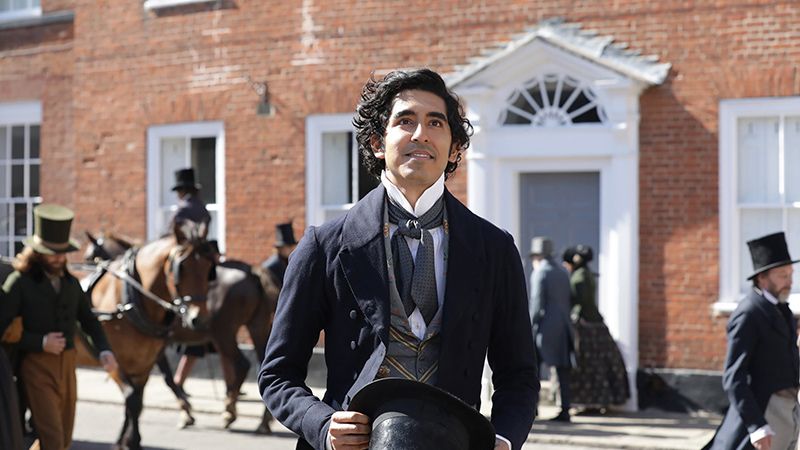The Personal History of David Copperfield
The Personal History of David Copperfield, 2020, 1 ¾ stars
Far afield from Dickens
Iannucci’s Copperfield feels like a stranger
Exclusive to MeierMovies, August 27, 2020
Charles Dickens and Armando Iannucci have train wrecks in common. Dickens survived one in 1865, and Iannucci just turned Dickens’ David Copperfield into one.
While the real wreck was terrible – killing 10, injuring 40 and leaving a physically and emotionally weakened Dickens – the new cinematic one, on a certain level, is a thing of originality and beauty. And, like a true locomotive crash, the film demands your attention. But Dickens’ novel – imbued with light comedy, heavy melodrama and a serial-like structure – is so ill-suited to writer-director Iannucci’s farcical leanings, rushed pacing, CliffsNotes structure and nontraditional casting that its heart is lost.
Dickens’ novel – first published in installments in 1849 and 1850 – paints a rich portrait of its title character from birth to young adulthood. Born to a widowed mother, David experiences various ups and downs along his journey. Typical of Dickens, David’s path is peppered with rich characters, including an evil stepfather (Edward Murdstone), a curmudgeonly aunt (Betsey Trotwood), a reckless school chum (James Steerforth), a cockeyed optimist (Wilkins Macawber), and a slimy antagonist (Uriah Heep).
This tapestry is better suited to the page than the screen. Indeed, unlike Great Expectations and Oliver Twist, no great David Copperfield film exists. Hollywood made a valiant attempt in 1935 with a version directed by George Cukor and produced by David Selznick. Though somewhat dated, it still holds charm today and is buoyed by memorable performances by W.C. Fields as Macawber, Basil Rathbone as Murdstone, Edna May Oliver as Trotwood and Maureen O’Sullivan as Dora (David’s wife). Elsa Lanchester and Lionel Barrymore show up in smaller roles. But, regrettably, the film completely excises David’s school years. So when Steerforth pops up late in the film, his context is lost. The 1974 BBC mini-series is arguably the truest screen adaptation of the novel. Trouble is, it looks and sounds like, well, a 1970s television show.
Perhaps owing to the failures of previous versions – or maybe just because of his unique sensibility – Iannucci has gone in a different direction. Though he attempts to sandwich in as much of the story as will fit, he mostly embraces farce and eschews sentimentality. Even more noticeably, Iannucci has adopted a color-blind, or integrated, casting, employing Dev Patel as David and an array of non-White actors in traditionally White roles. Some critics are applauding this decision, but before joining the chorus, please indulge my different take.
Nontraditional casting often works well in the theater, where realism is more easily set aside. And Iannucci himself has made some wonderfully unique casting decisions in previous films, such as The Death of Stalin. But his overbearing choices strain believability here, causing one to often focus on race rather than story.
Further, what’s the point of realism in production design, costumes, dialects and narrative if realistic casting is disregarded? Realism is less important than racial equality, one would say. But isn’t it a disservice to both ethnic justice and history to suggest that Black (and Indian and Chinese) citizens enjoyed parity with Whites in 19th-century England when, in fact, slavery had only just been abolished throughout the British Empire? (For information on historical African presence in England, visit Wikipedia.) And don’t we reach equality not necessarily by casting actors of color in historically White stories but by instead honoring Black, or at least color-neutral, stories?
When color-blind casting is used well, we should applaud it. (If it’s implemented with subtlety, sensitivity and maturity, you might not even notice it.) But when it doesn’t work, we shouldn’t be afraid to say so. Criticism of this type of casting is no more a rejection of inclusion and equality than is criticism of tokenism and quotas. Most importantly, engaging in this discussion shouldn’t result in one being labeled intolerant or closed-minded, and, unfortunately, in our currently polarized world, it often does. And if one indulges that polarization, the art of film criticism is doomed.
That’s not to say that the actors themselves aren’t admirable. Patel is heartfelt, but because the soul of the story belongs to young David, we’re left impatiently waiting for Patel to show up. (Few remember who played the adult David in the 1935 version. Instead, it’s Freddie Bartholomew as young David who has stuck in our minds.) Tilda Swinton as Trotwood is her usual weird self but can’t top Oliver from the old film. The same goes for Peter Capaldi as Micawber, who has the unenviable task of following Fields. (At least he swaps Fields’ Transatlantic sound for a real British dialect.) And as David’s friend and eventual love interest, Agnes, Rosalind Eleazar is competent, as is Ben Whishaw as Heep. But Benedict Wong as Wickfield (Agnes’s father and David’s employer) seems a bit lost.
It’s Hugh Laurie as Mr. Dick (the mentally unsound but endearing companion of David’s aunt) and Welsh actress Morfydd Clark as Dora who stand out, offering irresistible warmth and humor. In fact, Iannucci’s brilliantly metatheatrical treatment of Dora is almost the film’s saving grace. That achievement and some lovely art direction notwithstanding, Iannucci’s adaptation is a tiresome exercise in style over substance, experimental casting over narrative maturity, and farcical indulgences over genuine emotion. (By comparison, if you want to see a masterful reimagining of a literary classic, watch Joe Wright’s Anna Karenina.)
“Like many fond parents, I have in my heart of hearts a favorite child,” Dickens wrote. “And his name is David Copperfield.” I’m just glad Dickens isn’t around to see – paraphrasing Vito Corleone – how they massacred his boy.
© 2020 MeierMovies, LLC
